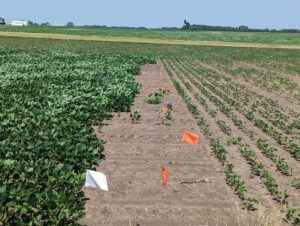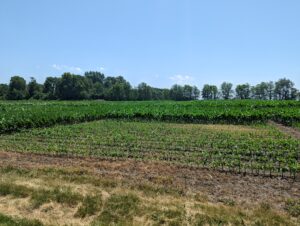Illinois Crops Update 6/24/22
Each week, I put out a request to crops educators and specialists from the University of Illinois to compile an update to share with the entire state. We hope you find this information useful. If you have any questions or suggestions about the format or any feedback in general about these updates, please email me (harbach2@illinois.edu).
Nick Seiter, Extension Field Crops Entomologist, University of Illinois
I’m receiving more reports of stink bugs than I typically do, and colleagues in surrounding states have made similar reports. A lot of the damage in Illinois at this point is cosmetic feeding on corn, but feeding at emergence can stunt plants and occasionally reach yield-limiting levels (see pictures below from a field I visited in 2018). Rootworm larvae are currently active, this is a good time for initial scouting and assessment of damage/control performance.
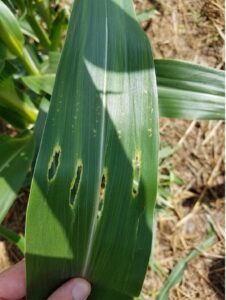

Emerson Nafziger, Extension Agronomy Specialist, University of Illinois
The big story remains the dry weather: on the US Drought Monitor released on June 23 describing conditions as of June 21, 41% of Illinois is in abnormally dry (D0) condition, and 6 percent is in moderate drought (D1). This includes about 10 counties in the northwest corner of Illinois, 10 counties in the southernmost part of the state, and more than 20 counties in east-central Illinois. The D1 region includes most of Vermilion, Champaign, DeWitt, Piatt, Douglas, and Moultrie counties. This is being called a “flash drought,” reflecting the fact that it developed quickly: on May 31, only 9 percent of the state was at D0, and none was at D1. Unfortunately, “flash” does not mean that it will disappear quickly.
Most of the corn in the D2 area, and fields that were planted later or have compacted or light-textured soils elsewhere are showing leaf curling in the afternoon, and many are starting to curl in the morning. In soybeans, leaves can appear limp in the heat of the day. The main effect to date has been lower growth rates due to losses in daily photosynthesis. Height increases have been limited in both crops due to difficulty in taking up enough water to fully expand cells. Leaf area increases have also been slowed, with smaller leaves in soybean, and corn in some fields not adding leaf stages as quickly as growing degree accumulations predict. As ongoing dry conditions continue to lower growth rates and make it increasingly difficult for crops to take up water, loss of yield potential will accelerate, starting first with corn.
Dennis Bowman, Extension Digital Ag Specialist, University of Illinois
While the week has been hot and rainless, a wind event last Friday the 17th cause significant amounts of snapped corn in areas of Macoupin County. Corn is significantly rolled in the afternoons. Soybean development seems to have stalled in many fields. On Thursday travels, wheat harvest is underway as far north as Carlinville and no-till planters are generally waiting on the edge. Soil moisture does not look good for double-crop soybeans at this time.
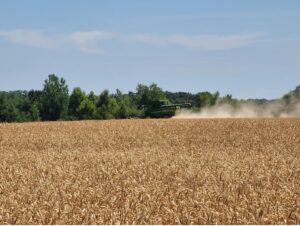
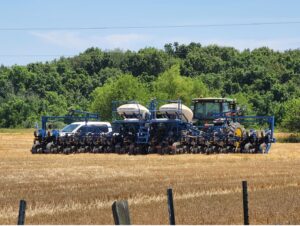
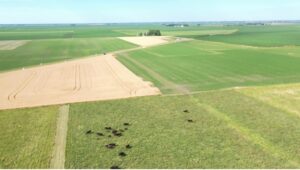
Talon Becker, Commercial Ag Extension Educator, Southern IL
Much of southern Illinois received some relief from the hot, dry weather last Friday morning from a storm system that moved through the area. However, reported precipitation totals were variable with some receiving not much more than 0.1″ while others got nearly 1″. That said, another hot, dry week this past week has continued to stress the crop in the areas that received little rain. And in the areas that received more rain, soil moisture is slightly better, but rolled corn leaves in the afternoon have become a common sight again over the past couple days. Soybean growth has slowed, while waterhemp and other weed pressure is starting to increase. Some may be considering applying their post-emergence herbicide programs in the next week or so, hopefully buying time for rain to boost soybean growth and canopy closure. Wheat harvest is wrapping up. Many have planted their double-crop beans, hoping for a rain to come soon.
Nathan Johanning, Commercial Ag Extension Educator, Southwestern IL
The weather has brought more of the same for this week. Hot and dry has been the theme with a slight break over the weekend but now highs back in the 90s to 100 degrees. Last Friday morning some scattered showers did come through bringing anywhere from nothing to 0.6″ in the area. With the heat and wind, the moisture did not last long. Crops show some stress in the afternoons but for now do recover in the evenings. Wheat harvest is on the downhill swing. The dry weather has been very favorable for harvest and good grain quality.
Chelsea Harbach, Commercial Ag Extension Educator, Northwestern IL
The western part of the state where I am located has yet to show up on the US Drought Monitor, but another rainless week this past week certainly puts us in jeopardy of reaching D0. There is a small amount of rain in the forecast for tomorrow, so I’ll remain optimistic that our crops will get a drink. The early planted soybeans look much better off than the later planted soybeans (see picture below). And corn is starting to roll up in the afternoon heat. With how dry and hot it has been, foliar fungal diseases are not of concern right now. Please keep weather in mind as you consider foliar fungicide applications. As long as the weather continues to be hot and dry, the threat of foliar fungal diseases remains fairly low, especially in soybean fields that have yet to close canopy.
